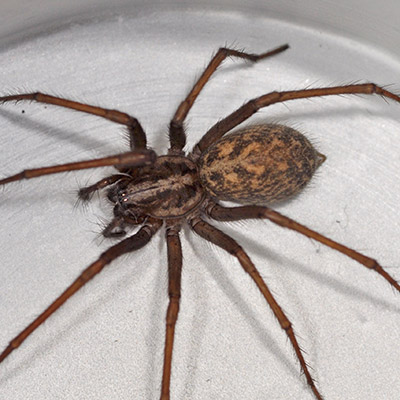
 |
|
Scientific Classifications explained » Amphibians » Ants » Aphids » Bees » Beetles » Birds » Bugs » Butterflies » Caterpillars » Damselflies » Dragonflies » Earwigs » Flies » Frog/Leafhoppers » Fungi » Galls » Grasshoppers » Harvestmen » Hoverflies » Lacewings » Ladybirds » Leaf Mines » Lichens » Mammals » Millipedes » Mosses » Moths » Sawflies » Slugs » Snails » Spiders » Trees » Wasps » Wild Flowers » Woodlice |
UK Nature > Spiders > Eratigena atrica

Scientific Name: Eratigena atrica Common Name: Giant House Spider Eratigena atrica, the Giant House Spider, has a body length of 10-18mm, with very long legs, especially in the male. The body is yellowish to reddish brown, heavily mottled with black and with a number of pale chevrons towards the rear. Most often seen scurrying across room floors at night, especially in the autumn, when the males are seeking mates. Spins triangular cobwebs in neglected areas of rooms, hiding in a tubular retreat in the corner, waiting for any unsuspecting flies or other insects to become entangled in the dense sheets of web they have constructed. Adult all year, the females living for several years and can survive months without food. In and around houses and other buildings, especially sheds and other out-buildings, but can be found out in open countryside, especially in the south. Very common throughout the UK. |
|

https://www.uknature.co.uk is a website dedicated to showing the immense diversity of UK nature and wildlife. Our vast range of habitats, from lowland arable to snow covered mountains, from storm-ravaged coastlines to peaceful inland freshwater lakes and rivers, from dry, sandy heaths to deciduous and coniferous forests, all these habitats contribute to the abundance of UK nature. We have wild birds in huge numbers either residing or visiting our shores (597 recorded species as at July 2013) and we must also not forget the humble back garden with its grass lawns, flower beds filled with nectar rich flowers, shrubs and trees, all designed to attract huge numbers of insects such as bees, moths, butterflies and hoverflies; and finally the small ponds which provide safe havens for frogs, toads, newts and even slow worms and grass snakes. www.uknature.co.uk is the showcase for my personal passion, photographing uknature in all its glory. I sincerely hope you all enjoy the fruits of my labours. This site and all images contained therein is © Jeremy Lee 2004 - 2021. All Rights Reserved. Site design by Jeremy Lee. Site development & IT Support by Stuart Lee. |